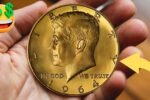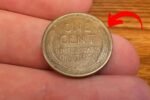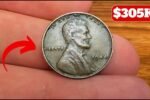If you’ve ever come across a small, brown penny featuring Abraham Lincoln on the front and two stalks of wheat on the back, you might’ve dismissed it as just another old coin. But don’t let its simple appearance fool you — that unassuming cent might actually be a Lincoln Wheat Penny, and it could be worth far more than just one cent.
In fact, some of these vintage coins are quietly making everyday people surprisingly wealthy. Collectors across the country are paying thousands — and in some cases, hundreds of thousands — of dollars for rare versions of this iconic American coin. So before you toss that penny into a tip jar, read on. You might be holding a small fortune in the palm of your hand.
What Is a Lincoln Wheat Penny?
The Lincoln Wheat Penny was first minted in 1909 to commemorate the 100th anniversary of Abraham Lincoln’s birth. It was the first U.S. coin to feature a real person — in this case, the beloved 16th President of the United States. On the reverse side, the coin displays two curved wheat stalks surrounding the phrases “ONE CENT” and “UNITED STATES OF AMERICA.”
This design was used from 1909 until 1958, when the U.S. Mint replaced the wheat design with an image of the Lincoln Memorial. Any penny minted during this earlier period that features the wheat stalks is officially classified as a Lincoln Wheat Penny.
Why Are Some Lincoln Wheat Pennies Worth So Much?
While millions of Lincoln Wheat Pennies were produced over the years, not all are created equal. Many are only worth their face value or slightly more, especially if they’re worn out or common. However, a few special coins can be worth thousands. Here’s why:
- Rarity – Some years had limited mint production, making those coins much harder to find.
- Mint Errors – Coins that were misprinted or include unusual features are highly sought after by collectors.
- Condition – Pennies in near-mint or uncirculated condition can fetch premium prices.
- Metal Composition – In rare cases, coins were made using the wrong metal, making them extremely valuable.
These factors have led to a thriving market among coin collectors, many of whom are willing to pay top dollar for the right Lincoln Wheat Penny.
Also Read – Maruti Suzuki Baleno Now Launched With More Amazing Features, Premium Look and Luxury Interiors
The 1943 Copper Lincoln Wheat Penny: A Million-Dollar Coin
Perhaps the most famous example of a valuable Lincoln Wheat Penny is the 1943 copper version. During World War II, copper was a critical material for the war effort, so the U.S. Mint switched to using steel for pennies that year. As a result, nearly all 1943 pennies are silver-colored steel coins.
However, a few copper blanks from 1942 were mistakenly used in the minting process. These error coins — the 1943 Copper Lincoln Wheat Pennies — are exceptionally rare. Only a few dozen are known to exist, and their value has skyrocketed.
One of these rare coins sold for over $1 million at auction. Others have fetched between $250,000 and $500,000 depending on their condition. For coin enthusiasts, finding one of these is the ultimate dream — and it might just be hiding in your coin jar.
Other Valuable Lincoln Wheat Pennies to Look Out For
While the 1943 copper penny grabs headlines, there are several other Lincoln Wheat Pennies worth watching for:
- 1909-S VDB: The very first year of the Lincoln cent included a version made in San Francisco with the initials of the designer, Victor David Brenner. This coin is highly collectible and can sell for thousands.
- 1914-D: This Denver-minted penny is scarce and desirable. High-grade versions can bring in several thousand dollars.
- 1922 No D: A minting error from Denver left the “D” mint mark off some coins. These are rare and valuable, especially in good condition.
- 1955 Double Die: This error coin features a clear doubling of the date and lettering. Depending on its condition, it can sell for between $1,000 and $10,000.
Each of these coins represents a piece of history — and potentially, a big payday.
How to Check Your Pennies for Value
If you’re intrigued and ready to start sifting through your change, here are a few simple tips to help you identify valuable Lincoln Wheat Pennies:
- Check the Year: Focus on pennies from 1909 to 1958.
- Look for Mint Marks: Located under the date, letters like “D” (Denver) and “S” (San Francisco) can make a big difference.
- Use a Magnet: All 1943 pennies should stick to a magnet (they’re steel). If yours doesn’t, it could be a rare copper version.
- Inspect for Errors: Look for doubled letters, missing dates, or off-center designs.
- Evaluate Condition: Coins in better condition are typically more valuable.
If you think you’ve found something special, consider visiting a local coin dealer or sending the coin to a grading service like PCGS or NGC for a professional appraisal.
Why Coin Collecting Is Trending Again
Coin collecting isn’t just a hobby for retirees anymore. Thanks to viral stories of people finding valuable coins in everyday places, younger generations are joining the fun. The Lincoln Wheat Penny, in particular, has captured the imagination of collectors old and new.
But it’s not just about the money. Every coin tells a story — of history, craftsmanship, and sometimes, surprising mistakes. Holding a rare penny is like holding a tiny piece of American heritage.
Final Thoughts: Don’t Overlook the Lincoln Wheat Penny
In the world of numismatics, the Lincoln Wheat Penny holds a special place. It’s accessible, historic, and — if you’re lucky — extremely valuable. So before you toss that old penny aside, take a closer look. You might just be holding a treasure worth thousands.
Who knew a simple copper coin could change someone’s life?
Some Important Link
| Telegram Group | Click Here |
| WhatsApp Group | Click Here |
| Home Page | Click Here |






